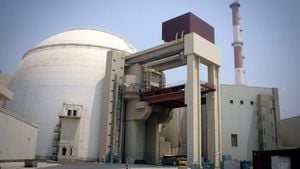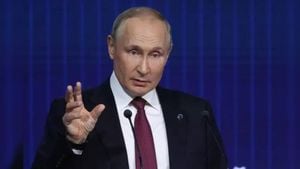Escalations dominate the conflict between Russia and Ukraine as recent missile strikes and military strategies have drawn global attention. Ukraine has made headlines by employing British-made Storm Shadow missiles against targets inside Russia, marking the first time these missiles have been used on Russian territory. This military maneuver, alongside increased support from the United States, seems to signify Ukraine's aim to not only defend its sovereignty but to also apply pressure on Russia.
U.S. officials revealed on November 20, 2024, the approval of these advanced munitions to bolster Ukraine’s defensive capabilities amid fears of significant Russian air attacks. This decision occurred against the backdrop of intense diplomatic discourse and military posturing, with the United States temporarily closing its embassy in Kyiv due to warnings of potential air strikes.
"Monday’s missile strikes represented over 210 drones and missiles targeting electricity substations across Ukraine, with fears rising of catastrophic failures at operational nuclear plants," Greenpeace’s Shaun Burnie commented based on the latest reports from Ukraine's energy infrastructure. The chain Reaction has raised alarms not only about Ukraine’s immediate safety but about potential ramifications for Europe due to the interconnectedness of energy resources.
The urgency of these developments is exacerbated by the geopolitical climate changed with Donald Trump’s impending return to the White House. Observers note the timing and potential for significant shifts as Trump has signaled readiness to negotiate peace, albeit with concerns about how this might affect support for Ukraine. Analysts assert: "Ukraine's position at the bargaining table could be predicated on its current military effectiveness."
Ukraine's utilization of American-made ATACMS missiles has drawn attention due to their role intended to disrupt Russian supply lines rather than strike directly at Moscow. U.S. officials have been reportedly cautious about the deployment of extensive military support for fear of provoking heightened threats from Russia, particularly concerning its nuclear arsenal. Former defense minister Tobias Ellwood expressed, "The stakes are incredibly high, and any miscalculation could lead to wide-scale devastation, extending well beyond the battlefield."
Ukraine's recent gains have been significant, with the country managing to hold onto previously captured Russian territories. This feat has triggered desperate responses from Russia, including enlisting troops from North Korea and intensifying attacks. This dual-climate of aggression and negotiation aims to seize favorable terms for future peace agreements.
Simultaneously, Russia ramped up its warfare tactics, sacrificing thousands of its soldiers for ground control. Reports estimate astounding casualties on both sides, with estimates ranging from 600,000 to 700,000 Russian troops affected since the onset of the conflict. Such numbers cast shadows on Russia’s operational capabilities and signal potential pivots in their approach depending on battlefield outcomes.
While both nations prepare for possible peace negotiations, recent military activities suggest the fighting may escalate. The volatile situation is underscored by President Vladimir Putin’s continued nuclear threats aimed at deterring U.S. involvement and intimidating Ukraine. "Engaging with offensive measures and channeling threats emphasizes the delicate balance of diplomacy and military engagement at play," remarked one expert following the coordination of strikes and military alliances.
Ukraine continues facing challenges such as unanticipated assaults and overwhelming numbers of Russian forces, which at times outnumber Ukrainian troops. Reports indicated fields along the front lines show disparities of more than six-to-one, heightening fears over Ukraine's defense capabilities as its forces prepare for winter battles.
With stories surfacing of reported attacks on humanitarian corridors and civilian targets, the international community watches with concern. Russian forces have faced allegations of committing war crimes, pushing the narrative of both nations to seek accountability for their military strategies. The prospect of peace remains elusive as each side strives to outmaneuver the other on and off the field.
U.S. advances have contributed significantly, with President Biden’s administration focusing on pouring more resources and military aid to support Ukraine's sustained effort against Russian advances. Reports on operational concerns involve utilizing drones and missiles to stave off encroachments, alluding to Western backing as fundamental to Ukraine's resilience.
Yet, the question remains — can the growing pressure on Russia mitigate its expansive military tactics without prompting retaliatory responses? Observers of international affairs need to explore these themes as the fate of war still hangs by threads of diplomacy alongside unwavering military support. The risks of potential dialogues could also hinge on whether Ukraine can remain steadfast against Russian initiatives as they navigate this tumultuous period.
Environmentally, the recent missile strikes targeting Ukraine’s electricity generation have raised alarms among environmental advocates. The energy crisis sparked by systematic attacks on substations has triggered serious concerns about nuclear safety and potential disasters akin to the Fukushima and Chernobyl incidents. Greenpeace experts urged immediate halts to these assaults, emphasizing the grave dangers associated with such military tactics on civilian infrastructure linked to nuclear power.
Despite the challenges on the ground, the remnants of hope lie within Ukraine’s strategic partnerships, military strategies, and the potential for international diplomacy to usher them toward lasting peace. Partners like the Netherlands have maintained commitments to supply warplanes, showing unity against Russian aggression.
This dynamic era of conflict, characterized by unprecedented turns, indicates the necessity for innovative problem-solving approaches from world leaders to address the inherent risks tied to warfare amid calls for humanitarian respect and sustained support. Moving forward, the international community must stay compact to monitor the shifting scenarios closely, maintaining solidarity with those affected by the conflict and tirelessly pursuing pathways to justice and peace.



